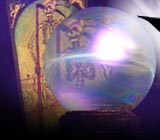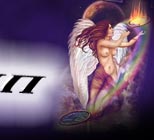|
I Ching
This is the ancient system of Chinese wisdom often used in oracular divination.
It consists of 64 hexagrams of solid and broken lines. The hexagram is
determined by tossing three coins, three times by the inquirer. The I-Ching
is based upon an entire philosophy which is the unified and cyclical universe,
the future develops according to fixed laws and numbers. In other words,
there is no "coincidence" or "chance", but only casuality.
The I-Ching does not give definitive answers (similar to Tarot) but enables
the inquirer to look within themselves for answers. Psychiatrist Carl
jung appreciated the I-Ching as it demonstrated the principal of "Synchronicity."
(Meaningful coincidences)
The I-Ching philosophy itself is thought to date back thousands of years.
But the hexagrams according to tradition were developed by Emperor Fu-hsi
around 2852 BC.
Solid lines on the hexagrams represent Yang (male) and the broken lines
Yin. (Female).
Originally Fu-hsi developed 8 Tri-grams which were then doubled into 64
hexagrams by King Wen in 1143 BC. This then inspired Lau-Tzu (604 BC -
531 BC) who used it for writing of "Tau Teh Ching" which is
the central text of Taoism. Confucius (C.551 BC - 479 BC) was also inspired
in his life and added 10 commentaries which are known as the "Ten
Wings" appendices. In 213 BC Emperor Chin had numerous books burnt
amongst them were the Confucian commentaries to the I-Ching although some
copies survived. The final writings connected with the I-Ching did not
reach the west until the 19th Century when it was translated into German
and then into English. The publication of these translations included
a forward by Jung.
|







